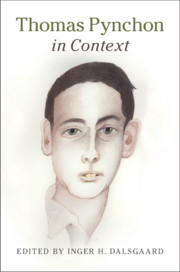Book contents
- Thomas Pynchon in Context
- Thomas Pynchon in Context
- Copyright page
- Contents
- Contributors
- Abbreviations
- Chronology
- Introduction
- Part I Times and Places
- Part II Culture, Politics, and Society
- Part III Approaches and Readings
- Chapter 34 Narratology
- Chapter 35 Genre
- Chapter 36 Postmodernism
- Chapter 37 Ambiguity
- Chapter 38 Realities
- Chapter 39 Material Readings
- Chapter 40 Digital Readings
- Chapter 41 Internet Resources
- Chapter 42 Fandom
- Chapter 43 Book Reviews and Reception
- Chapter 44 Critical Literature Review
- Further Reading
- Index
Chapter 36 - Postmodernism
from Part III - Approaches and Readings
Published online by Cambridge University Press: 31 May 2019
- Thomas Pynchon in Context
- Thomas Pynchon in Context
- Copyright page
- Contents
- Contributors
- Abbreviations
- Chronology
- Introduction
- Part I Times and Places
- Part II Culture, Politics, and Society
- Part III Approaches and Readings
- Chapter 34 Narratology
- Chapter 35 Genre
- Chapter 36 Postmodernism
- Chapter 37 Ambiguity
- Chapter 38 Realities
- Chapter 39 Material Readings
- Chapter 40 Digital Readings
- Chapter 41 Internet Resources
- Chapter 42 Fandom
- Chapter 43 Book Reviews and Reception
- Chapter 44 Critical Literature Review
- Further Reading
- Index
Summary
When Thomas Pynchon published his first novels in the early- and mid-1960s, nobody called them postmodern, for the very good reason that the term barely existed at that time. If anyone felt the need to categorize them, perfectly suitable categories were available: V. (1963) and The Crying of Lot 49 (1966) were satires, or perhaps examples of black humor. By the mid-1980s, Pynchon had been canonized as the very model of a postmodernist, and Gravity’s Rainbow (1973) in particular, his third book, as the definitive postmodern novel. In the interim, the term had gradually made inroads in literary circles, and then in the mid-1970s had leapt to architectural theory and criticism, which disseminated it far and wide, until it seemed that everything in the sphere of culture, high and low, could be called “postmodern.” By the early 1990s, writers and academics were beginning to declare postmodernism dead – prematurely, as it turned out. By the 2010s, however, it had receded to background noise.
- Type
- Chapter
- Information
- Thomas Pynchon in Context , pp. 289 - 297Publisher: Cambridge University PressPrint publication year: 2019



